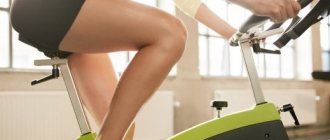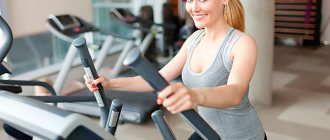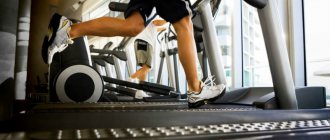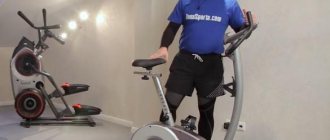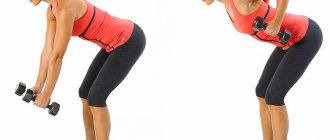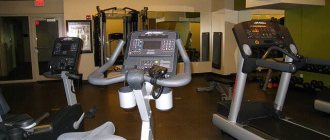How to lose weight on an exercise bike is a question of interest to those who prefer to exercise at home, with comfort, benefit and pleasure. Let’s take a closer look at why an exercise bike is indicated for weight loss.
Cycling is a type of cardio training, which includes running, but compared to it, cycling has many advantages:
- uniform load distribution. In both running and cycling, the entire “impact” is taken by the legs, but on a bicycle, without loss of efficiency, this load is reduced by the pedals;
- reduction of vibration load. Running is essentially jumping in motion, during which internal organs are subjected to strong shaking. On a bicycle, the upper part of the body makes progressive, systematic movements without dangerous effects on the internal part of the body;
- gradual improvement of blood circulation. Compared to running, training on a bicycle accelerates the blood much more slowly (remember the assistants - the pedals), which allows you to train the body consistently;
- the ability to change the static position. While running, a person is always in a certain vertical position, while on a bicycle there is an excellent opportunity to straighten up, bend, throw back your arm, that is, to stretch tired parts of the body;
- opportunity to do other things. Racing on a home bike station allows you to watch TV shows, talk with loved ones and even read.
How to choose an exercise bike for home weight loss
Cardio equipment is manufactured with different types of load, which affects the ease of use and cost of the device. There are:
- mechanical - they are set in motion by a person when he rotates the pedals;
- magnetic - with permanent magnets that are located inside the flywheel;
- electromagnetic - operate from the mains, the smoothest and most functional type.
By design or type of planting there are:
- Horizontal - the pedals are placed in line with the seat, due to which the legs are straightened. Cardio machines minimize stress on your back, neck and joints. A striking example is Oxygen Apollo and Svensson Body Labs Heavy G Recumbent.
- Vertical - classic models, the fit is identical to the fit on a real bicycle. The pedals are located under the seat, the steering wheel is equipped with comfortable handles. Vertical models can be found in the lines of such manufacturers as DFC, Spirit Fitness, Sport Elite. Size and functionality vary, but many modern machines come equipped with a computer with training programs.
Types of cycling
The cycle training process is divided into two stages:
- exercises performed directly on the simulator itself;
- power complexes carried out next to it.
Thus, cardio alternates with intense exercise, which does not allow you to slow down and interrupt the process of burning fat deposits. Contrary to stereotypes, calorie loss begins from the first minutes of training, however, maximum consumption is achieved only when combined with strength loads. From a medical point of view, an intensive complex should last no more than 25-30 minutes, otherwise it may harm the body. In cycling training, an alternation technique is introduced, which allows you to change the type of load without losing intensity.
Exercises in training are divided into 6 types:
- Rapid rotation of the pedals is combined with a vertical body position.
- Downhill or uphill. This element is performed at an intense rhythm, sitting, with the inclusion of an additional load mode.
- Change of pace and position. At the coach’s command, the angle of the athlete’s body changes.
- Power load. During this period, various types of weights and small dumbbells are connected. The exercise is performed while sitting on the machine or standing next to it.
- Blitz sprints are a sharp increase in the intensity of exercise while sitting or standing for short periods of time.
- Standard temp. Used as an unloading pause between intensive blocks.
All types of training in a certain order and with the required frequency of alternation are included in the sets that form the main types of cycling: SpinBegin, InterSpin, SpinForce. These names indicate the levels of training of athletes and the types of loads for them, namely:
- elementary;
- average;
- professional.
No matter what level of training the trainee considers himself to be, at first he will always be offered a beginner level, because he is a beginner in this sport. After the start of classes, the trainer himself will determine the client’s degree of readiness for loads based on the results of measuring the body’s main indicators while performing the exercises. Professional cycling is characterized by a high pace of exercise, which is not always immediately possible even for people with good physical fitness.
Club Cycle at La Salute
How many kilograms can you lose
The elliptical and exercise bike are used for weight loss, although their initial task is to increase endurance and maintain body tone. To get rid of excess weight, they need to be combined with diet and other physical exercises.
The most effective workouts are in the morning, carried out before breakfast. At this time, there is a low glycogen content in the blood, as a result of which subcutaneous fat is burned faster. If it is not possible to conduct classes in the morning, they can be moved to the evening (but no later than 2-3 hours before bedtime) and increase the total duration by 20 minutes.
Depending on the speed, in 1 hour of cycling you will lose from 5 to 8 calories per 1 kg of weight. That is, you can actually lose 3-5 kg in a month. When you combine cardio training with other activities and a low-calorie diet, the figure will increase.
5 More Tips to Increase Efficiency
There are tips that you should listen to:
- Cycling training will be effective only if you follow the principles of a rational and balanced diet.
- Give up desserts and everything you are supposed to buy for tea.
- Your daily menu must include proteins (boiled or baked fish or chicken, vegetable dishes, fresh herbs, lactic acid products with a small percentage of fat).
- It is advisable to add gymnastic exercises, Pilates, and yoga to cycling training. This will allow for more harmonious development of all major muscle groups.
- The speed of weight loss is different for everyone, so don’t rely on others, just follow the recommendations for proper nutrition and regimen, and adhere to the energy consumption table.
Attention! Exercise regularly, for example every other day.
The body will recover well and rest fully. Also check out the video on the topic:
Remember that all training programs are advisory in nature. When trying out a workout, adapt it to yourself, your schedule and capabilities. Take into account your general level of physical fitness, health status, and the presence of extra pounds. If you are overweight, be gentle with yourself and do not set high intensity levels.
Include different types of physical activity in your cycling training - swimming, brisk walking, oriental exercises (yoga). Then the weight will go away gradually without threatening your health, and the lost kilograms will not return.
What parts of the body lose weight on an exercise bike?
Many beginners use an exercise bike to lose weight; only those who adhere to the daily exercise plan leave positive reviews. If you train correctly, you can work the following muscles:
- calf;
- femoral;
- gluteal;
- flexion;
- lumbar
Additionally, the stomach and sides are involved, a little - the back and shoulder girdle. The more intensively the area is worked, the more it tightens. If an athlete cannot independently monitor the intensity, programs built into the cardio machine will come to his aid.
Seat position
Correctly adjusting your seating position is very important because:
- improper fit can impair blood circulation and create harmful stress on the joints;
- If the support is incorrect, the effect on the leg muscles is reduced, which reduces the effectiveness of the entire exercise.
The structure of an exercise bike
There are 3 types of exercise bikes - vertical, horizontal and spin bikes.
When using vertical ones, it is important to consider:
- you need to sit upright, keep your head straight;
- Do not arch your lower back and strain your arms;
- Be sure to place your knees parallel to each other;
- The feet should be placed straight, toes forward.
To operate this device correctly, place the seat 5 centimeters below the level of the steering wheel. The bend of the leg at the lowest point should be 135-145 degrees. It is necessary to lower the seat slightly if your hips move while riding the machine.
Vertical trainer
The position on horizontal devices is:
- your back is close to the seat, your shoulders are straight;
- your posture should remain straight, even if you hold the handles;
- If necessary, you can use special pillows to avoid slouching.
Horizontal devices are adjusted as follows: at the moment when the leg is at the farthest point, you need to make sure that the bend angle at the knee is about 135 degrees. The ideal position is when you do not need to move away from the backrest to pedal.
Recumbent exercise bike
The spinbike assumes the following landing:
- the body should be almost parallel to the floor;
- the back can be slightly rounded;
- It is also permissible to bend the lower back a little.
The seat should be at the same level as the steering wheel, slightly away from it.
Spinbike
How often should you exercise
If you use an exercise bike or elliptical trainer for weight loss, and not for strengthening the body or maintaining health, then the frequency must be increased by 2-3 times. The optimal frequency for losing extra pounds is 5 times a week.
There is no need to exercise every day - the body needs time to rest and recover. Beginners who decide to lose weight through daily cycling quickly burn out and lose interest in the sport, as they do not see results in a short time.
When the load provided by a cardio machine is not satisfactory, you can add other physical activity. For example, abdominal pumping, squats or exercises with dumbbells.
Useful video
Also watch interesting videos on the topic:
In order to get comfortable with cycling training, it is important to use tips and recommendations on exercise technology and a balanced diet. In this case, the weight will steadily decrease without overexertion and loss of strength. This will serve as excellent motivation and will help you make such exercises a mandatory part of your daily routine.
Having reduced weight to the desired level, it is important to maintain the achieved results and ride an exercise bike for preventive purposes.
Duration of training
An exercise bike for weight loss will be effective if you start using it little by little. Beginners and people with poor health should train for 5-15 minutes a day, gradually increasing the duration to 30, 40 and 60 minutes. At first, beginners burn more calories than experienced athletes, since the load is unfamiliar to the body. Once a person gets used to it, the fat burning process slows down.
Professionals are advised to stick to 45-60 minutes. This is enough to warm up the body, work out muscles, strengthen the cardiovascular system and lose weight.
Driving speed is of considerable importance. For example, in 20 minutes of cardio training at 15 km/h you can burn 150 kcal, at 30 km/h – 200 kcal, and at 35 km/h – 250 kcal. If it is difficult to determine the speed, you can turn to the built-in complexes and follow standard programs.
Errors during classes
The most common mistakes are usually made by beginners. Usually there are several of them:
- Neglecting a cool down. This leads to muscle clogging, soreness and the inability to continue training due to pain.
- Excessive pressure on the pedals and, as a result, excess energy consumption and overexertion.
- Sharp relaxation after intensive training. Leads to knee injuries and hip pain. After a heavy load at a fast pace, your legs should not dangle limply on the pedals.
- Overvoltage. You can't waste your energy clinging to the steering wheel. The goal of the training is to control your movements and use the correct technique.
- Unauthorized exercise. Cycle training programs are specially designed for specific cycles. Violation of the built system leads to harmful mistakes, injuries and lack of results.
Training program
What's good about an exercise bike for weight loss is its ability to change the pace of exercise. Cardio training can be regular, at the same pace, or interval. A standard interval program includes the following complex:
- five-minute warm-up - at minimum speed;
- five-minute preparation – speed 17-20 km/h with moderate pedal resistance, inclination angle is 2%;
- ten-minute cardio training - alternating minimum and maximum loads for 30-60 seconds each;
- cool down – speed and resistance are reduced to a comfortable pace, the incline returns to 0%;
- ten-minute break - breathing and light exercises.
For women, the cardio load is set less than for men. It is important to take into account the pulse - it should not rise above 100-120 beats in unprepared people and people with a weak heart. Breathing should not be interrupted and lead to dizziness - this is fraught with falls and injuries.
User reviews and results
Real reviews say that the exercise bike really helps you lose weight. The main thing is to constantly increase the pace and intensity of your training.
“For those who still doubt whether an exercise bike helps you lose weight, I want to tell you about my results. In 3 winter months I lost 8 kilograms without leaving home! I just turned on my favorite TV series every evening and pedaled at an average speed.”
So you shouldn’t give up exercising on an exercise bike. Regular workouts will definitely help you achieve your dream figure.
Answers to frequently asked questions
1. Which is better for losing weight: a treadmill or an exercise bike?
The running belt enhances fat burning by 20-30%, and with it you can achieve results faster. But it is worth considering that running is not beneficial for everyone - it is more traumatic for the knees and joints than cycling. If you want to increase the efficiency of your bike, you should take a closer look at spin bikes.
2. Who is contraindicated to exercise?
You should avoid training if you have diabetes, neoplasms, thrombophlebitis, diseases of the cardiovascular system and musculoskeletal system, bronchial asthma, and hypertension. If chronic illnesses have worsened or the flu has appeared, training should be postponed until you feel better.
It is worth stopping the exercise if dizziness, nausea, rapid heartbeat, chest pain appear, breathing becomes erratic, and blood pressure rises.
Contraindications
Due to the fact that the loads during cycling are higher than training on a regular exercise bike, there are a number of contraindications for this direction:
- hypotension and hypertension;
- heart diseases;
- pregnancy at all stages;
- varicose veins and thrombophlebitis;
- chronic joint pathologies.
Before starting classes, you should definitely visit a therapist and get a certificate of no contraindications. Experienced cycling trainers conduct a preliminary conversation with each new client, monitor his physical indicators during training, determine how long the lesson will last, and prescribe the appropriate type of exercise, set of loads and intervals between them.
Since cycling is an intense and dynamic sport, classes must be started under the supervision of a trainer. A professional will select the types of exercises and tell you how to perform them correctly so that the beginner does not encounter injuries such as sprains and dislocations. Cycling is especially harmful for those with weak knee joints. If there are such problems, it is not recommended for a beginner to practice on his own.
